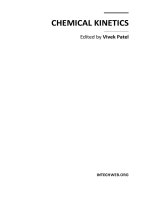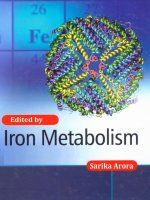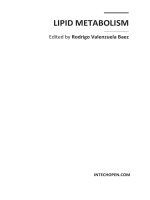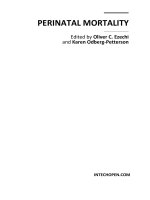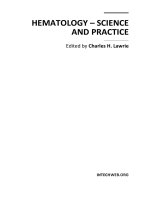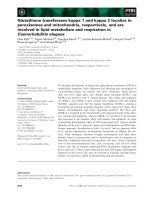Lipid Metabolism Edited by Rodrigo Valenzuela Baez pot
Bạn đang xem bản rút gọn của tài liệu. Xem và tải ngay bản đầy đủ của tài liệu tại đây (15.91 MB, 472 trang )
LIPID METABOLISM
Edited by Rodrigo Valenzuela Baez
Lipid Metabolism
Edited by Rodrigo Valenzuela Baez
Contributors
Rodrigo Valenzuela B., Alfonso Valenzuela B., Claudia Borza, Danina Muntean, Cristina
Dehelean, Germaine Săvoiu, Corina Şerban, Georgeta Simu, Mihaiela Andoni, Marius Butur,
Simona Drăgan, Jason L. Burkhead, Svetlana Lutsenko, Line M. Grønning-Wang, Christian
Bindesbøll, Hilde I. Nebb, Jasmina Dimitrova-Shumkovska, Leo Veenman, Inbar Roim, Moshe
Gavish, Paul K. Crellin, Chu-Yuan Luo, Yasu S. Morita, Yasuo Uchiyama, Eiki Kominami, Alicia
Huazano-García, Mercedes G. López, Fang Hu, Yingtong Zhang, Yuanda Song, Heather M.
White, Brian T. Richert, Mickey A. Latour, Heli Putaala, Bożena Waszkiewicz-Robak, Miguel A.
Martín-Acebes, Ángela Vázquez-Calvo, Flavia Caridi, Juan-Carlos Saiz, Francisco Sobrino, Luca
Siracusano, Viviana Girasole, Christine Tayeh, Béatrice Randoux, Frédéric Laruelle, Natacha
Bourdon, Delphine Renard-Merlier, Philippe Reignault, Yuanxin Yan, Eli Borrego, Michael V.
Kolomiets, Yong Zhang, Heping Zhang
Published by InTech
Janeza Trdine 9, 51000 Rijeka, Croatia
Copyright © 2013 InTech
All chapters are Open Access distributed under the Creative Commons Attribution 3.0 license,
which allows users to download, copy and build upon published articles even for commercial
purposes, as long as the author and publisher are properly credited, which ensures maximum
dissemination and a wider impact of our publications. After this work has been published by
InTech, authors have the right to republish it, in whole or part, in any publication of which they
are the author, and to make other personal use of the work. Any republication, referencing or
personal use of the work must explicitly identify the original source.
Notice
Statements and opinions expressed in the chapters are these of the individual contributors and
not necessarily those of the editors or publisher. No responsibility is accepted for the accuracy
of information contained in the published chapters. The publisher assumes no responsibility for
any damage or injury to persons or property arising out of the use of any materials,
instructions, methods or ideas contained in the book.
Publishing Process Manager Sandra Bakic
Typesetting InTech Prepress, Novi Sad
Cover InTech Design Team
First published January, 2013
Printed in Croatia
A free online edition of this book is available at www.intechopen.com
Additional hard copies can be obtained from
Lipid Metabolism, Edited by Rodrigo Valenzuela Baez
p. cm.
ISBN 978-953-51-0944-0
Contents
Preface IX
Section 1 Introduction to Lipid Metabolism 1
Chapter 1 Overview About Lipid Structure 3
Rodrigo Valenzuela B. and Alfonso Valenzuela B.
Section 2 Molecular Aspects of Lipid Metabolism 21
Chapter 2 Oxidative Stress and Lipid Peroxidation –
A Lipid Metabolism Dysfunction 23
Claudia Borza, Danina Muntean, Cristina Dehelean, Germaine
Săvoiu, Corina Şerban, Georgeta Simu, Mihaiela Andoni,
Marius Butur and Simona Drăgan
Chapter 3 The Role of Copper as a Modifier of Lipid Metabolism 39
Jason L. Burkhead and Svetlana Lutsenko
Chapter 4 The Role of Liver X Receptor in Hepatic de novo Lipogenesis
and Cross-Talk with Insulin and Glucose Signaling 61
Line M. Grønning-Wang, Christian Bindesbøll and Hilde I. Nebb
Chapter 5 The 18 kDa Translocator Protein and Atherosclerosis
in Mice Lacking Apolipoprotein E 91
Jasmina Dimitrova-Shumkovska, Leo Veenman,
Inbar Roim and Moshe Gavish
Chapter 6 Metabolism of Plasma Membrane
Lipids in Mycobacteria and Corynebacteria 119
Paul K. Crellin, Chu-Yuan Luo and Yasu S. Morita
Chapter 7 Autophagy Regulates Lipid
Droplet Formation and Adipogenesis 149
Yasuo Uchiyama and Eiki Kominami
VI Contents
Chapter 8 Metabolism of Short Chain Fatty Acids in
the Colon and Faeces of Mice After a Supplementation
of Diets with Agave Fructans 163
Alicia Huazano-García and Mercedes G. López
Section 3 Lipid Metabolism in Health and Disease 183
Chapter 9 Lipid Metabolism, Metabolic Syndrome, and Cancer 185
Fang Hu, Yingtong Zhang and Yuanda Song
Chapter 10 Impacts of Nutrition and Environmental
Stressors on Lipid Metabolism 211
Heather M. White, Brian T. Richert and Mickey A. Latour
Chapter 11 Polydextrose in Lipid Metabolism 233
Heli Putaala
Chapter 12 Spent Brewer’s Yeast and Beta-Glucans Isolated
from Them as Diet Components Modifying Blood Lipid
Metabolism Disturbed by an Atherogenic Diet 261
Bożena Waszkiewicz-Robak
Chapter 13 Lipid Involvement in Viral Infections:
Present and Future Perspectives for
the Design of Antiviral Strategies 291
Miguel A. Martín-Acebes, Ángela Vázquez-Calvo,
Flavia Caridi, Juan-Carlos Saiz and Francisco Sobrino
Chapter 14 The Role of Altered Lipid Metabolism
in Septic Myocardial Dysfunction 323
Luca Siracusano and Viviana Girasole
Chapter 15 Lipids as Markers of Induced Resistance in Wheat:
A Biochemical and Molecular Approach 363
Christine Tayeh, Béatrice Randoux, Frédéric Laruelle,
Natacha Bourdon, Delphine Renard-Merlier and Philippe Reignault
Section 4 Lipid Metabolism in Plants 391
Chapter 16 Jasmonate Biosynthesis, Perception and Function in Plant
Development and Stress Responses 393
Yuanxin Yan, Eli Borrego and Michael V. Kolomiets
Chapter 17 The Effect of Probiotics on Lipid Metabolism 443
Yong Zhang and Heping Zhang
Preface
Fats and oils are a large group of chemical structures different in shape, size and
physicochemical characteristics, collectively identified as lipids. Ancestrally, lipids
were fundamental components in the early human diet, providing an important and
valuable amount of energy (9 kcal / g 37.7 kJ / g) and other components, such as
essential fatty acids, fat soluble vitamins and sterols (such as cholesterol and/or
phytosterols). The different structural characteristics of lipids give them multiple
biochemical, physiological and nutritional functions, being transcendental to our body
and allowing, among other functions, the development and growth of highly
specialized tissues, such as the brain.
Lipids have been important in the evolution of many species and especially for the
human being. At present a significant number of studies have demonstrated the role of
lipids in the development, prevention and / or treatment of various acute and chronic
diseases. The present book, "Lipid Metabolism", discuss in its various chapters the
importance of lipid metabolism in humans and other species.
The first section of the book is dedicated to the structure and general metabolism of
lipids, with emphasis on the structural and metabolic differences of each lipid.
Regarding lipid metabolism, the main features from their absorption and digestion are
also discussed, highlighting in particular the complexity of lipoprotein metabolism.
At molecular level lipid metabolism is even more complex. Some chapters revise and
discuss the close relationship between some lipids and i) the cell membrane structure
ii) the regulation of intracellular signaling pathways, iii) the direct interaction with
gene transcription factors iv) the regulation of gene expression, and v) the effect of
lipid peroxidation in cellular metabolism. All these interactions involving lipid
metabolic products show the relevance of these molecules in the maintenance of
normal structural, organic and systemic cellular activity.
Currently, a central element in the study of lipid metabolism is the participation of
these molecules in the development and the prevention of certain diseases, especially
those of chronic non communicable nature such as, obesity, insulin resistance, diabetes
mellitus, atherosclerosis, cardiovascular disease and cancer. It is well known the
association of some saturated fatty acids, such as palmitic acid (C16: 0) or of
X Preface
cholesterol, with the increased risk of cardiovascular diseases, or the effect of the
imbalance of omega-6 and omega-3 fatty acids in the course of inflammatory process
and its posterior resolution.
An interesting aspect of lipid metabolism refers to its importance in plants where, such
as in animals, lipids represent more than an energy reservoir, highlighting as
regulatory elements in the metabolism and in the functional properties of many
vegetables, and having a direct impact on the health and nutrition of the human and
animal population.
Collectively, the book intent to be a systematic and comprehensive review of lipid
structure and metabolism. Special emphasis is made to the functional characteristics of
some lipids, such as membrane phospholipids. Some chapters discuss the molecular
aspects of lipid metabolism, its interaction with oxidative stress, and particularly the
close relationship of some lipids with health and disease.
Rodrigo Valenzuela Baez, Nutricionist. Msc. PhD.
Assistant Professor
Fats and Oils in Food and Nutrition Research
Nutrition and Dietetics School
Faculty of Medicine
University of Chile
Santiago,
Chile
Section 1
Introduction to Lipid Metabolism


